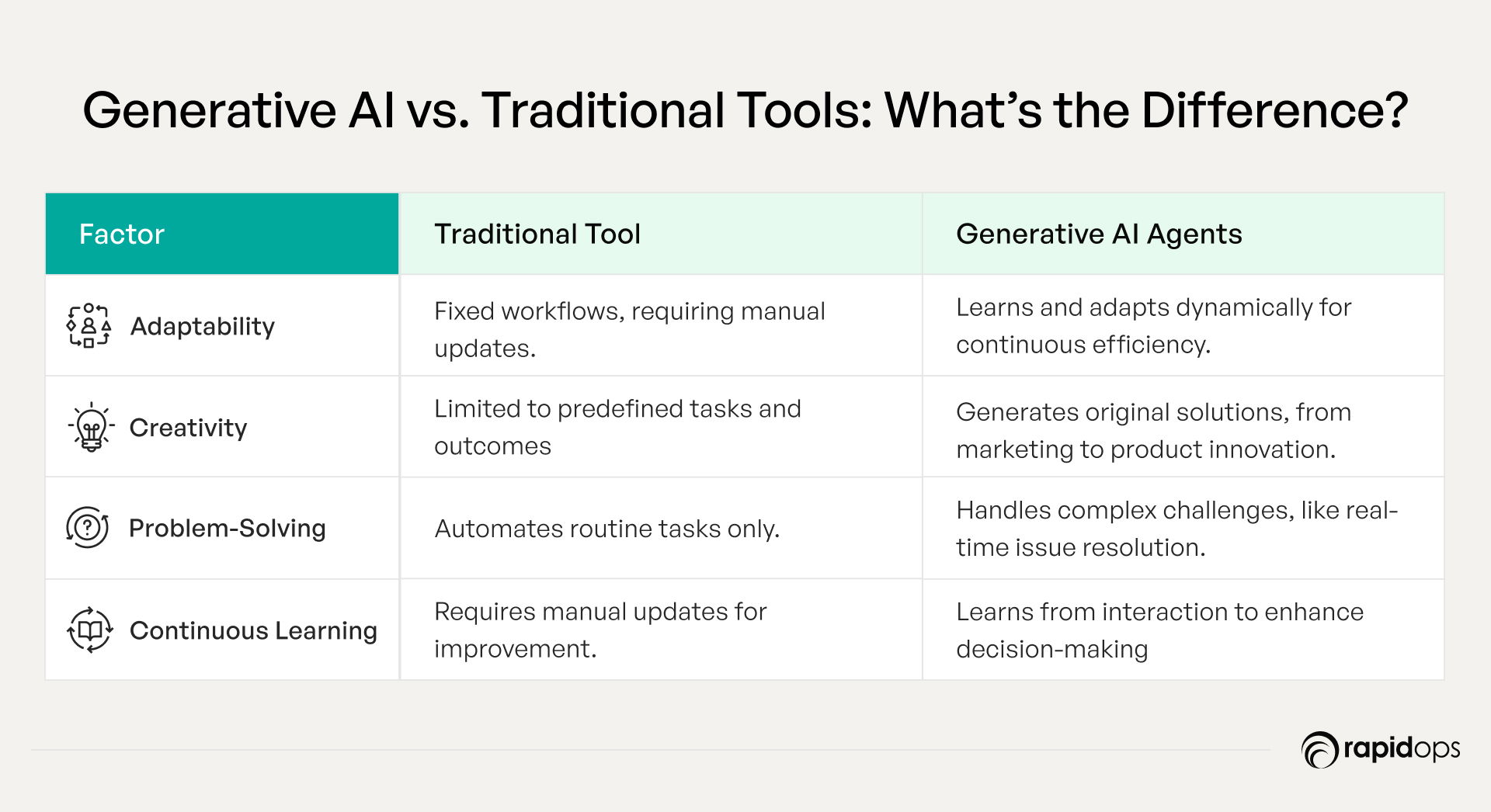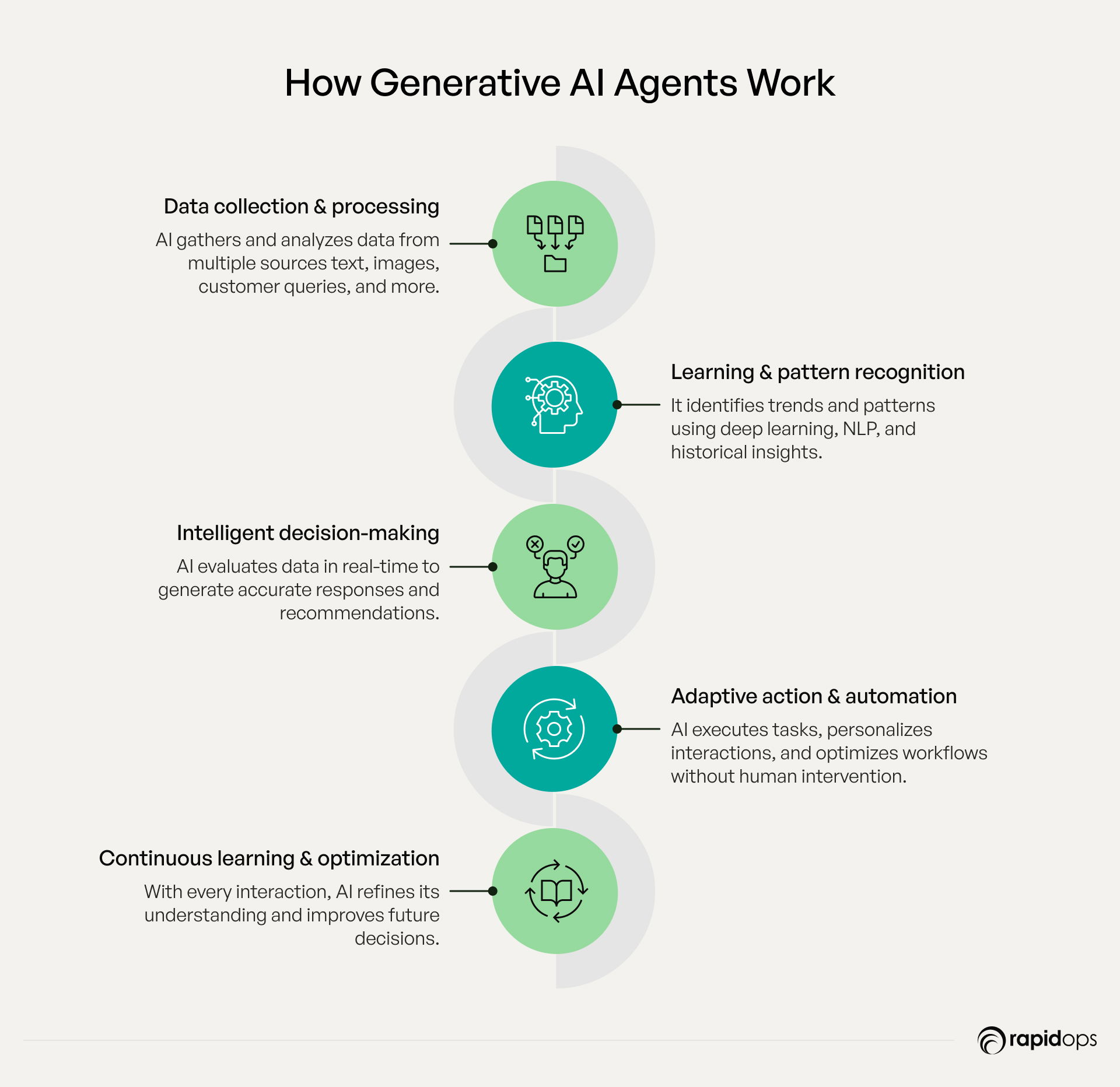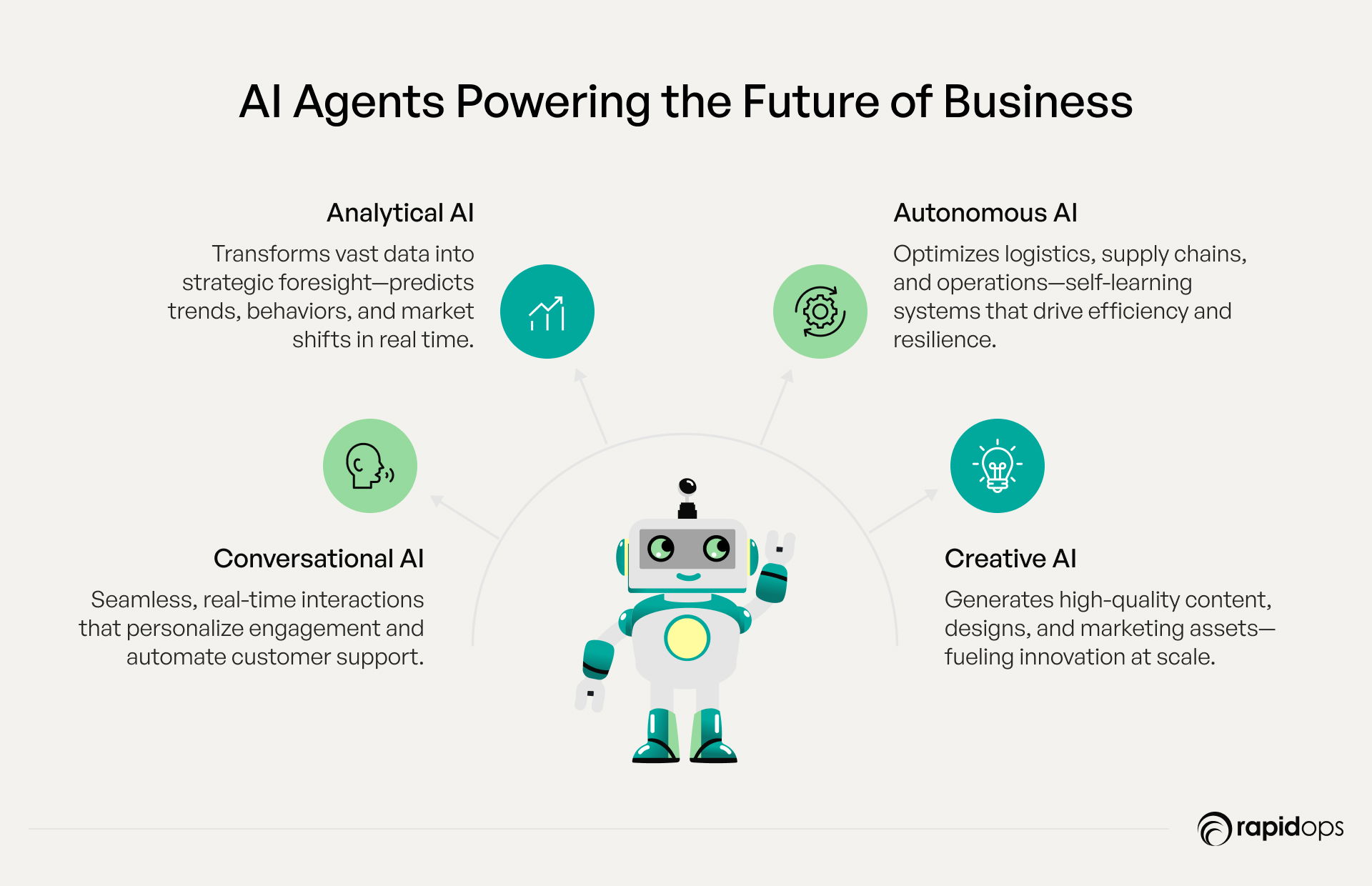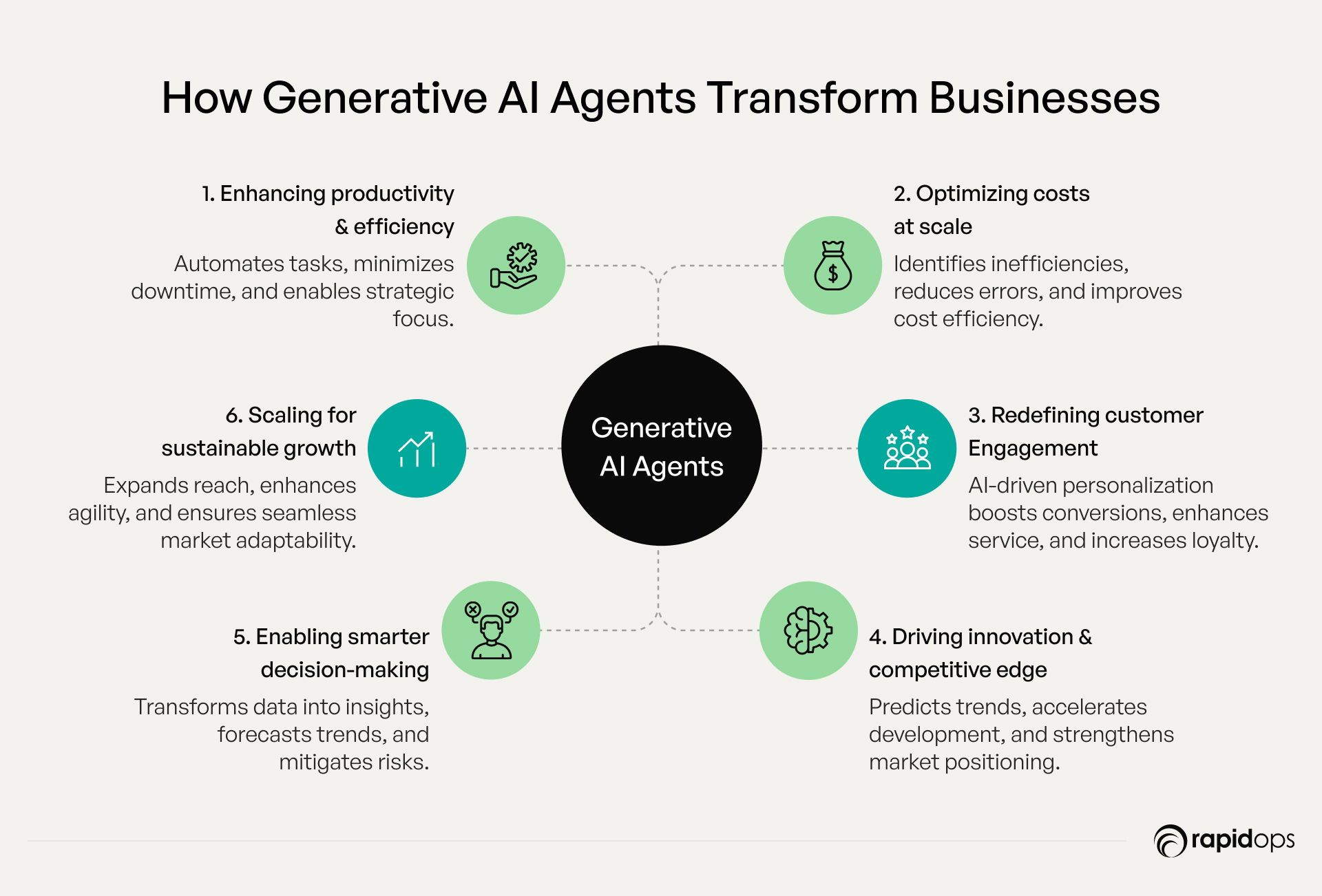The business landscape is evolving rapidly, and traditional strategies are no longer enough to maintain a competitive edge. How can companies scale operations, enhance customer experiences, and drive efficiency in this fast-changing digital era?
One answer lies in Generative AI agents, intelligent systems revolutionizing industries by automating workflows, personalizing interactions, and improving decision-making. Once considered futuristic, these AI-driven assistants are now essential tools for businesses looking to stay ahead.
The shift is accelerating. Gartner projects the global AI market will grow from $93.5 billion in 2021 to over $500 billion by 2024, reflecting AI’s rapid move from experimental adoption to mainstream integration. But this goes beyond automation, companies leveraging Generative AI are solving complex challenges, unlocking new efficiencies, and driving innovation at unprecedented speeds. Those who hesitate risk falling behind as AI-powered competitors redefine industry standards.
So, what exactly are Generative AI agents, and why are they indispensable? This article explores their capabilities, impact on business growth, and how they can be your next competitive advantage.
Generative AI Agents: What They Are and Why They Excel
What Are Generative AI Agents?
Generative AI agents are advanced software systems powered by artificial intelligence models that perform tasks autonomously, produce human-like outputs, and adapt over time. Unlike traditional automation tools, which follow pre-defined instructions, these agents generate new content, make real-time decisions, and continuously improve through learning. They represent a transformative leap, combining creativity, adaptability, and problem-solving to revolutionize business processes.
What Makes Generative AI Agents So Powerful
Create Content
Generative AI agents are not just tools for automation; they are catalysts for innovation in strategic areas. By creating unique outputs whether text, images, or tailored solutions these agents enable businesses to rapidly scale creative functions and streamline customer interactions.
They drive competitive differentiation, especially in industries like marketing, product development, and design, where speed, creativity, and personalization are paramount. The ability to generate high-quality, contextually relevant content at scale not only accelerates time-to-market but also enhances brand engagement.
Understand Context
Equipped with advanced Natural Language Processing (NLP), generative AI agents engage in complex, human-like conversations. This capability transcends basic automation, offering businesses a seamless, intuitive interface for customer support, sales, and internal decision-making processes.
As a result, executives can leverage these AI agents to reduce friction in communication channels, deliver highly personalized experiences, and foster stronger customer loyalty ultimately improving bottom-line performance.
Make Data-Driven Decisions
Generative AI agents go beyond simply processing data, they analyze vast, multi-dimensional datasets to generate actionable insights that drive strategic decisions.
By identifying emerging trends, forecasting potential outcomes, and offering data-backed recommendations, these agents empower executives to make more informed, confident decisions in real time. This results in optimized operations, smarter investments, and more effective risk management strategies, enabling businesses to pivot quickly in today’s volatile market.
Learn and Adapt
Machine learning is the backbone of generative AI agents, enabling them to continuously adapt and refine their outputs based on new data and changing conditions. This dynamic adaptability ensures that businesses remain agile, ready to capitalize on new opportunities or mitigate risks as they emerge.
As companies integrate these AI agents into their business models, they enhance long-term sustainability by aligning with evolving market demands and maintaining a competitive edge through ongoing optimization.
How Do Generative AI Agents Outperform Traditional Tools?
Generative AI agents outperform traditional tools by delivering faster, more adaptive, and context-aware support. Unlike static systems, they learn from interactions, personalize responses, and scale effortlessly.

1. Adaptability
- Traditional Tools: Rely on fixed workflows and require manual updates for changes.
- Generative AI Agents: Continuously learn and adapt to dynamic inputs, ensuring sustained efficiency.
2. Creativity
- Traditional Tools: Limited to repetitive tasks and predefined outcomes.
- Generative AI Agents: Create original solutions, such as personalized marketing campaigns or innovative product designs.
3. Dynamic Problem-Solving
- Traditional Tools: Automate routine tasks only.
- Generative AI Agents: Handle complex challenges, like optimizing supply chains or resolving customer issues in real time.
4. Continuous Improvement
- Traditional Tools: Depend on manual updates to improve.
- Generative AI Agents: Learn autonomously from interactions, enhancing accuracy and decision-making.
How Generative AI Agents Work
Generative AI agents represent the cutting edge of artificial intelligence, functioning as dynamic systems that integrate multiple advanced technologies to perform complex tasks autonomously. Unlike standalone tools, these agents rely on the synergy of various components natural language understanding, machine learning, data processing, and generative models to operate effectively.
Their ability to interact, adapt, and generate results lies in how these technologies combine to deliver intelligent and impactful solutions. Below is a step-by-step breakdown of how generative AI agents work as unified systems to achieve their capabilities:

1. Understanding and Interpreting Input: The Foundation of Human-Like Interactions
The first step in any generative AI agent’s operation is to process and understand the input it receives whether it’s a customer query, a business problem, or operational data. This stage leverages advanced Natural Language Processing (NLP) and data interpretation techniques to go beyond just analyzing words and phrases by capturing context, sentiment, and intent.
How It Works
NLP algorithms extract meaning from textual or verbal inputs by analyzing sentence structure, identifying key entities, and understanding the broader context. For example, in a customer service scenario, the agent identifies the customer’s issue, urgency, and tone while referencing historical data for context.
Why It Matters
Without this depth of understanding, responses would be generic or irrelevant. This contextual layer ensures that the AI agent provides meaningful, tailored solutions rather than superficial interactions.
2. Processing and Learning: The Core of Continuous Improvement
Once the input is understood, the agent processes the data to generate insights or take action. This stage involves advanced Machine Learning (ML) and data analysis models that enable the agent to learn from patterns and adapt over time.
How It Works
Machine learning algorithms process structured and unstructured data to identify trends and predict outcomes. For example, in supply chain management, the agent analyzes past inefficiencies, demand patterns, and real-time data to recommend optimized strategies.
Reinforcement learning enables the agent to improve its decision-making based on feedback loops, ensuring continuous refinement.
Why It Matters
This adaptability ensures that generative AI agents evolve with changing inputs and circumstances, delivering increasingly accurate and valuable results over time.
3. Generating Output: Crafting Dynamic, Context-Driven Responses
The generative capability of these AI agents shines when they create outputs tailored to specific needs. Whether it’s drafting personalized emails, producing business insights, or brainstorming creative solutions, this stage leverages generative models like GPT (Generative Pre-trained Transformer).
How It Works
The agent synthesizes the processed input and contextual data to craft output that aligns with user intent. For example, a generative AI agent can create an executive summary of a business report by extracting key details and presenting them in a concise, actionable format.
Generative models enhance the agent’s ability to handle creative or complex tasks that require a high level of personalization.
Why It Matters
This step enables organizations to scale creativity and efficiency, allowing leaders to focus on strategic decision-making rather than manual content creation.
4. Dynamic Integration: Creating a Unified Intelligent System
Generative AI agents achieve their functionality through the seamless integration of technologies and workflows. NLP, ML, generative models, and real-time data processing don’t operate in silos but work together as part of a cohesive system.
How It Works
Data flows dynamically between components, enabling real-time processing and adaptation. For example, in customer service, the agent simultaneously analyzes user sentiment (NLP), predicts the best course of action (ML), and generates a response (generative model).
APIs and other integration tools connect the AI agent with business systems, ensuring it has access to the necessary resources and data.
Why It Matters
This interconnectedness transforms the agent from a simple automation tool into an intelligent system capable of delivering holistic solutions that align with organizational goals.
5. Real-Time Execution: Delivering Value at Scale
The final stage involves executing tasks or delivering results based on the insights and outputs generated by the agent. Whether it’s automating workflows, providing recommendations, or supporting decision-making, the agent’s real-time execution ensures timely and relevant outcomes.
How It Works
The agent acts autonomously or assists users by implementing decisions based on predefined parameters or learned preferences. For example, in financial services, an agent can execute trade decisions or generate risk assessments in real-time.
Why It Matters
Real-time execution reduces delays, enhances operational efficiency, and allows businesses to respond swiftly to changing circumstances.
Practical Example: How Generative AI Agents Manage End-to-End Operations
Let’s consider a customer service example to illustrate the process:
- Input Understanding: The agent receives a customer query asking for product troubleshooting.
- Data Processing: It identifies the issue by analyzing the query, referencing the product manual, and reviewing past interactions with the customer.
- Learning: Based on previous queries of a similar nature, the agent determines the most effective solution.
- Output Generation: It crafts a personalized response explaining the solution step-by-step.
- Execution: The agent follows up with real-time guidance or connects the customer to a technician if needed.
Types of Generative AI Agents
Generative AI agents are categorized based on their functionalities and applications, each designed to solve specific business challenges, improve operational efficiency, drive innovation, and enhance customer engagement.

1. Conversational Agents (Chatbots and Virtual Assistants)
Conversational agents leverage natural language processing (NLP) and machine learning to engage customers in real-time. These agents automate communication, ensuring businesses provide quick, personalized responses while freeing human employees from routine inquiries.
Role and Applications
- Customer Service: Conversational agents handle common queries (e.g., order tracking, password resets, account management). This reduces human intervention, optimizes operational efficiency, and enhances customer experience through quick response times.
- Real-Time Engagement: By analyzing customer preferences and historical data, conversational agents tailor responses that feel personal and timely, boosting satisfaction, trust, and engagement.
Distinctive Feature
Conversational agents excel in handling high-volume queries, enabling businesses to scale their customer service capabilities. They reduce costs and improve efficiency, while enhancing customer retention through seamless, 24/7 service.
2. Analytical Agents
Analytical agents process vast datasets in real-time, providing businesses with actionable insights that improve decision-making. These agents continuously enhance their ability to analyze data, offering businesses increasingly refined and valuable information.
Role and Applications
- Business Intelligence: Analytical agents analyze operational, market, and customer data, helping businesses identify trends and formulate strategies for growth and efficiency. Their speed and accuracy enable timely decision-making.
- Trend Analysis: These agents predict consumer behavior, market shifts, and potential risks, enabling proactive strategies and optimizing business operations in competitive environments.
Distinctive Feature
The ability of analytical agents to process large data sets with increasing precision allows businesses to make smarter decisions faster, gaining a competitive edge in volatile markets and minimizing risks.
3. Autonomous Agents
Autonomous agents automate precision-based, repetitive tasks without the need for human oversight, improving business operations with high efficiency and minimal errors.
Role and Applications
- Logistics and Supply Chain: Autonomous agents optimize delivery routes, manage real-time inventory, and automate shipping. This reduces operational costs, improves resource allocation, and ensures timely deliveries, all while minimizing human error.
- Manufacturing: These agents manage production workflows, monitor machinery, and handle predictive maintenance. By proactively addressing potential failures, they reduce downtime, ensuring smooth production cycles and improved throughput.
Distinctive Feature
Autonomous agents increase business efficiency by automating complex tasks at scale, ensuring accuracy and improving decision-making while reducing operational costs. Their independence also frees up human resources for more strategic activities.
4. Creative AI Agents
Creative AI agents support innovation by assisting businesses in generating content and design that stands out in a competitive market. These agents help streamline creative processes while maintaining high-quality outputs.
Role and Applications
- Content Creation: From personalized marketing campaigns to dynamic visuals, creative agents automate content creation, accelerating time-to-market and enabling consistent brand messaging across platforms.
- Product Development and Branding: These agents assist in brainstorming new ideas, prototyping, and aligning branding strategies with business objectives, fostering innovation and helping companies stay ahead of trends.
Distinctive Feature
Creative AI agents drive innovation at scale, producing unique content quickly and efficiently, which gives businesses a competitive edge in the market and helps maintain creativity in a fast-paced industry.
Embracing generative AI agents empowers businesses to not only optimize their operations but also to stay agile and ahead of the curve, transforming challenges into growth opportunities in a constantly evolving market.
What Are the Benefits of Generating AI Agents for Businesses?
Generative AI agents are transforming industries by delivering intelligent, adaptive, and scalable solutions. These systems go beyond traditional technologies, offering capabilities that address modern business challenges with precision and innovation. Here’s an exploration of their most impactful benefits:

1. Revolutionizing Operational Efficiency and Productivity
Imagine a business where employees focus solely on innovation, leaving repetitive tasks to AI. Generative AI agents make this a reality by automating processes like data processing, scheduling, and reporting, saving valuable time and resources.
What sets them apart is their ability to prevent disruptions proactively. For instance, in manufacturing, AI predicts maintenance needs, reducing downtime by up to 40%. This proactive efficiency ensures businesses operate seamlessly, allowing teams to concentrate on strategic growth.
2. Empowering Smarter Cost Optimization
What if cost-saving didn’t mean compromising quality?
Generative AI agents uncover inefficiencies in operations, such as energy overuse or supply chain bottlenecks, and recommend actionable solutions to reduce waste. These agents also streamline high-error tasks, ensuring accuracy while cutting operational costs.
According to McKinsey, businesses leveraging AI report up to 20% cost savings, creating space to reinvest in critical growth areas like R&D, employee training, or customer experience enhancement.
3. Delivering Personalized, Proactive Customer Experiences
Meeting customer expectations today requires more than quick service—it demands personalization. Generative AI agents analyze real-time customer behavior, delivering tailored recommendations and interactions that drive loyalty and satisfaction.
AI-powered chatbots and virtual assistants offer instant, 24/7 support, reducing wait times and ensuring meaningful engagement. Retailers leveraging AI-driven product recommendations, for instance, see up to a 30% increase in sales, proving that personalization translates directly to business success.
4. Unlocking Creativity and Driving Innovation
Innovation often feels elusive, but generative AI agents bring it within reach. These agents analyze market trends, consumer needs, and competitive gaps to inspire groundbreaking strategies and ideas.
In creative industries, they amplify output by generating high-quality content, campaign ideas, and even product prototypes. For example, AI-driven marketing campaigns tailored to audience preferences boost engagement and ROI significantly. PwC reports that over 50% of executives credit AI with sparking innovation, making it a powerful ally in staying ahead of the curve.
5. Enabling Precision in Data-Driven Decision Making
Data is powerful only when it leads to clear, confident decisions. Generative AI agents turn overwhelming datasets into actionable insights, uncovering patterns, forecasting trends, and assessing risks.
Whether optimizing supply chains or predicting market demand, these agents empower leaders to make data-backed, strategic decisions. PwC’s "Global AI Study" reveals that over 70% of executives consider AI crucial for agile decision-making, ensuring businesses remain adaptable and forward-thinking.
6. Seamless Scalability for Growing Businesses
Scaling a business often comes with growing pains—generative AI agents eliminate them. These systems adapt effortlessly to increasing demands, maintaining performance without sacrificing quality.
Their multilingual and cross-functional capabilities enable businesses to expand globally while providing localized solutions. A report by IDC highlights that businesses using scalable AI achieve up to 40% greater operational flexibility, ensuring they remain competitive and agile in rapidly evolving markets.
Generative AI agents aren’t just tools, they’re transformative partners. By integrating these systems, businesses can enhance efficiency, inspire innovation, and create customer experiences that drive loyalty and growth. For decision-makers, the time to embrace AI isn’t tomorrow it’s today.
How Companies Are Driving Transformation with Generative AI Agents
LuxeThreads
What challenges did the company face?
LuxeThreads, a US-based premium fashion retailer, struggled to maintain a personalized connection with their growing online customer base. They needed to differentiate themselves in a competitive market by enhancing customer engagement and streamlining digital operations.
How did the company solve their problems?
LuxeThreads implemented generative AI agents across their eCommerce ecosystem. Key steps included:
- Integration with Existing Systems: The AI agents were seamlessly integrated with LuxeThreads' CRM and eCommerce platform to ensure smooth operations.
- Dynamic Customer Support: AI agents handled inquiries via chat, email, and voice, providing instant and accurate responses, reducing resolution times by 40%.
- Hyper-Personalized Marketing: Generative AI analyzed customer preferences and generated tailored product recommendations and marketing content, boosting campaign effectiveness.
- Creative Content Generation: AI agents produced product descriptions, promotional emails, and ad copy, reducing content creation timelines by 60%.
What results did the company achieve?
- Enhanced customer loyalty with a 25% increase in repeat purchases.
- A 22% rise in average order value through AI-driven upselling and cross-selling.
- Operational efficiency improved as automation reduced support staff workload by 35%.
What can business leaders learn from this case study?
LuxeThreads demonstrated how generative AI agents empower retailers to deliver high-touch, personalized customer experiences at scale, ensuring a competitive edge in a dynamic market. Leaders can use this case as a benchmark for adopting scalable, customer-focused AI solutions.
PrecisionParts Inc.
What challenges did the company face?
PrecisionParts Inc., a US-based manufacturer of automotive components, faced inefficiencies in managing its complex supply chain and ensuring effective communication with global suppliers. Manual errors and delays in order processing were negatively impacting operations.
How did the company solve their problems?
PrecisionParts Inc. deployed generative AI agents using a phased approach to ensure seamless implementation and minimize disruptions:
- Automated Documentation: AI agents generated purchase orders, invoices, and technical specifications with 99% accuracy, reducing manual errors and saving significant time.
- Enhance Supplier Communication: Real-time updates and AI-driven query resolutions cut supplier response times by 50%.
- Provide Data-Driven Insights: AI analyzed operational data to identify bottlenecks and recommend optimizations, improving decision-making.
- Scalability: The AI system was designed to adapt as the company expanded its supply chain network.
What were the results for the company?
- Automated workflows saved over 2,000 hours annually, allowing teams to focus on strategic initiatives.
- Supply chain reliability improved with a 45% reduction in delays and strengthened supplier relationships.
- A 20% reduction in operational costs boosted profitability.
Why should decision-makers take note from this case study?
PrecisionParts Inc. showcased how generative AI agents can streamline manufacturing operations, delivering measurable cost savings and enhancing efficiency. C-suite leaders can draw valuable lessons on how to improve operational agility and minimize risks with scalable AI solutions.
Generative AI Agents Are Transforming Business, How Will You Adapt?
The future of business is being shaped by generative AI agents, not as a passing trend but as a fundamental shift in how companies analyze data, optimize operations, and engage customers. Forward-thinking leaders are no longer asking “Should we adopt AI?” but rather “How do we strategically position our business to thrive in an AI-driven world?”
Companies that act early are already gaining a competitive edge, automating processes, making smarter decisions, and delivering hyper-personalized experiences at scale. But AI isn’t just about efficiency; it’s about staying agile, anticipating market shifts, and building a resilient, future-ready business.
At Rapidops, we help business leaders explore AI’s potential, identifying high-impact opportunities, mitigating risks, and building strategic AI roadmaps that drive real business outcomes.
The AI transformation is already here. Will your business lead the change or struggle to keep up? Let’s discuss how generative AI can shape your future. Schedule a free consultation with our AI experts to explore how AI can fit into your business strategy.

Rahul Chaudhary
Content Writer
With 5 years of experience in AI, software, and digital transformation, I’m passionate about making complex concepts easy to understand and apply. I create content that speaks to business leaders, offering practical, data-driven solutions that help you tackle real challenges and make informed decisions that drive growth.
What’s Inside
- Generative AI Agents: What They Are and Why They Excel
- How Generative AI Agents Work
- Types of Generative AI Agents
- What Are the Benefits of Generating AI Agents for Businesses?
- How Companies Are Driving Transformation with Generative AI Agents
- Generative AI Agents Are Transforming Business, How Will You Adapt?

Let’s build the next big thing!
Share your ideas and vision with us to explore your digital opportunities
Similar Stories
- AI
- 4 Mins
- September 2022

- AI
- 9 Mins
- January 2023


Receive articles like this in your mailbox
Sign up to get weekly insights & inspiration in your inbox.

